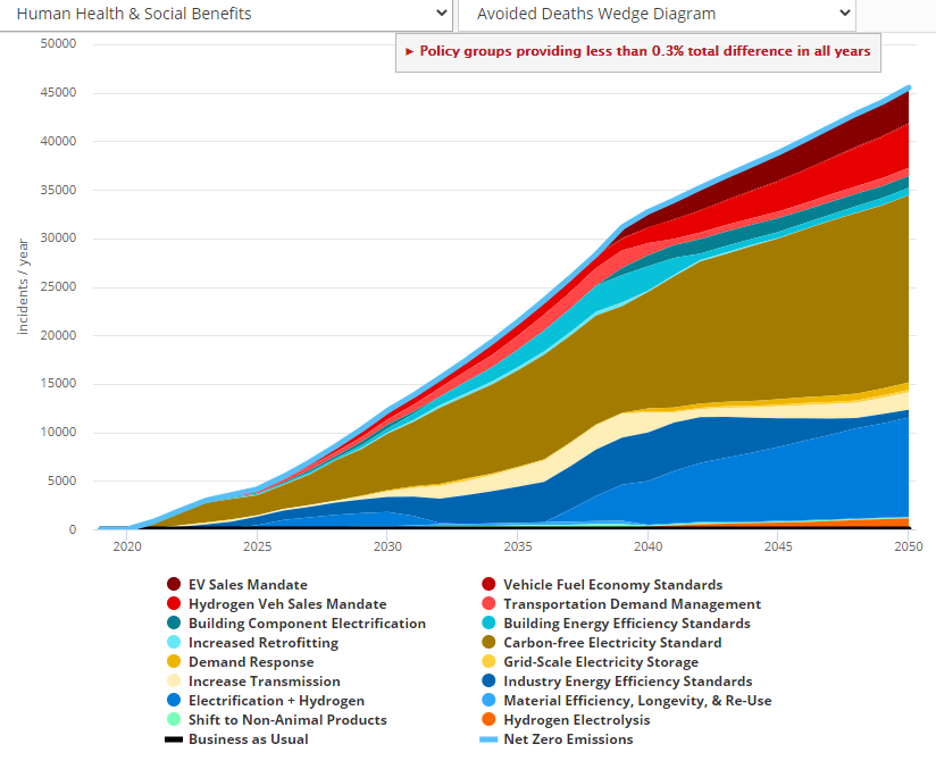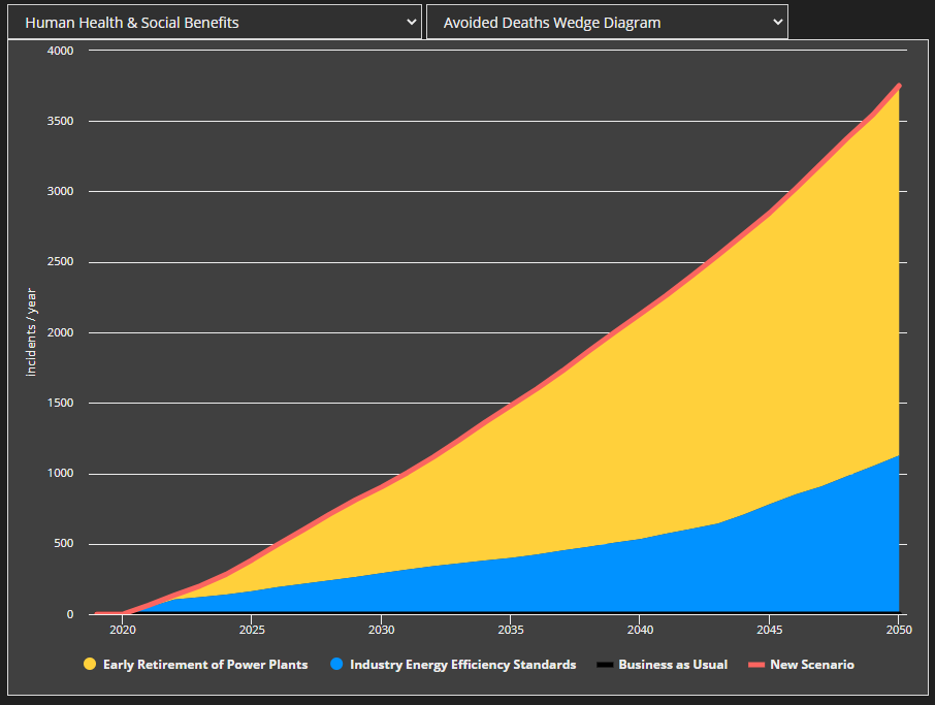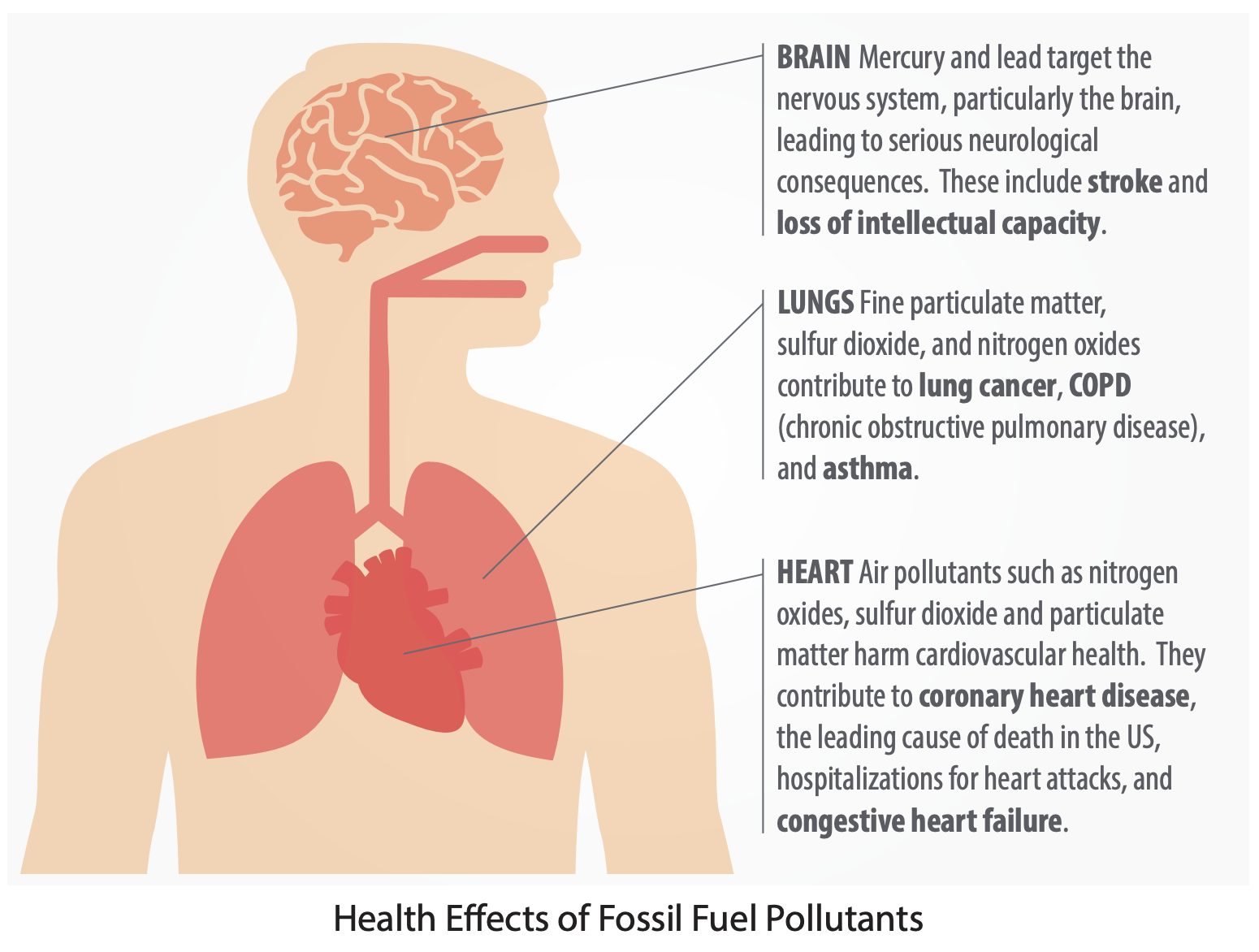By Sarah Spengeman and Surili Patel, Director, Center for Climate, Health and Equity, American Public Health Association
The vast majority of the pollution that damages human health is produced by burning fossil fuels to power our homes, cars, and businesses. But it doesn’t have to be this way.
The newest version of the Energy Policy Simulator (EPS) finds a set of clean energy policies that achieve net-zero emissions by 2050 would save more than 45,000 lives while preventing 1.3 million asthma attacks, more than 25,000 hospital admissions, and almost 4.5 million lost workdays every year by 2050. When we switch to clean sources of energy, we save lives, avoid hospital visits, and improve our quality of life. It’s that simple.

Avoided deaths in a net-zero scenario
The EPS online modeling tool estimates environmental, economic, and health impacts of dozens of climate and energy policies spanning every economic sector. It’s free and open to everyone – all you need is a web browser – and is based on objective, publicly available data. The EPS can produce clear cost and emissions figures, along with visually compelling, interactive, and easily shared graphics.
The latest EPS version provides a powerful tool for communicating clean energy and climate policy’s tremendous health benefits. The model shows how a wide range of policies affect greenhouse gas emissions and other pollutants including nitrogen oxides (NOx), sulfur oxides (SOx), and particulate matter (PM 2.5/PM 10) – three of the most damaging pollutants for human health. The EPS models how climate and energy policies cut these pollutants and shows associated reductions in deaths and morbidity.
The EPS has long allowed users to simulate the interactions of climate policies on emissions, costs, savings, along with avoided monetary climate damages and avoided premature mortality. The updated model now also incorporates U.S. Environmental Protection Administration data to demonstrate impacts on ten additional health outcomes – revealing how ambitious and achievable climate and clean energy policies saves thousands of lives while preventing asthma and heart attacks, respiratory symptoms, hospitalizations, lost workdays, and more.
Users can model policy packages or explore health impacts of a single policy, such as a clean energy standard or an electric vehicle sales mandate. One key EPS feature is the ability to see interactions among policy choices. For example, improving industrial energy efficiency 10 percent saves 1,756 lives annually by 2050, while early retirement of 750 megawatts’ coal-fired power plants saves 2,895 lives annually by 2050. But enacting these policies together saves 3,751 lives annually by 2050, 900 fewer lives than the sum of enacting the two policies individually (4,651 lives/yr). This is because decarbonizing the electric grid means reducing electricity consumption via efficiency measures saves fewer lives than if the electric grid retains fossil fuels.

Avoided deaths in a Early Retirement of Power Plants and a Industry Energy Efficiency Standards scenario
In addition to demonstrating how climate and clean energy policies reduce morbidity associated with air pollution, the new update also provides impacts on gross domestic product (GDP), jobs, and wages. The net zero-scenario referenced above, for example, adds roughly 4 million jobs in the 2040s and increases GDP roughly 3 percent, both driven by additional spending. Spending is directly increased by purchasing cleaner and more efficient equipment, but the largest increase comes from households and businesses buying goods and services with money saved from lower energy bills. The EPS shows that strong climate policies protect health and support a livable planet, but also create millions of jobs that provide financial security for families. Financial security, in turn, is an important social determinant of physical and mental health.
Most people are moved from concern to political action by the belief that climate change has a real and sizeable impact on their lives and their loved ones. The increasing frequency and severity of hurricanes in the Southeast and wildfires along the West Coast make it clearer than ever that climate change is not a distant threat: It is impacting American residents today. Advocates who want results must communicate this reality to policymakers and to those they aim to mobilize, while demonstrating the immediate benefits of climate solutions for health, jobs, and overall quality of life. The EPS provides that capability.
Climate policy is health policy
We know policies that accelerate the transition from burning fossil fuels to clean energy reduce planet-warming emissions, but they also reduce other pollution generated by fossil fuel combustion. Air pollution is a major cause of death and disease, killing an estimated 7 million people around the world every year and harming human health through asthma and respiratory diseases, heart attacks, strokes, pre-term and low-weight births, cognitive impairment in children, depression, and increased risk of suicide.
Not all people are impacted equally: Children and the elderly are more vulnerable, as well as people who work outdoors and experience homelessness. A legacy of structural racism and pervasive redlining has intentionally sited fossil fuel power plants and freeways adjacent to or within communities of color, generating persistent higher rates of exposure to harmful pollution among these communities. We cannot achieve health equity without climate and clean energy policies that deliver environmental equity.

Source: American Council for an Energy Efficient Economy and Physicians for Social Responsibility
Exposure to NOx and SOx irritates airways, causing difficulty breathing and triggering asthma attacks. Regular exposure to these pollutants can worsen heart disease and lung cancer and cause early death. NOx and SOx can also form fine particulate matter (PM2.5) via chemical reactions in the atmosphere.
PM 2.5 is also emitted directly from fossil fuel power plants and automobile tailpipes and is the most hazardous type of air pollution. Particulate matter, including what is commonly known as “soot,” refers to tiny solid or liquid particles that are so small they can be inhaled deep into the lungs and pass into the bloodstream. Particles less than 2.5 micrometers in diameter pose a very serious threat to health.
The World Health Organization has labeled PM 2.5 a carcinogen, because it is closely associated with lung cancer. Because it passes into the bloodstream, PM 2.5 also contributes to heart attacks, stroke, and heart failure. Even short-term exposure can trigger a heart attack. PM 2.5 persists in the atmosphere and can travel long distances from its source, making it particularly difficult to reduce exposure.
In the U.S., the predominant source of these pollutants is burning coal, oil, and gas for energy, creating deadly health consequences. The EPS demonstrates how ending our reliance on the dirty fossil fuels that are polluting our air and making us sick – even killing us – is critical to protecting public health.

Xcel Energy’s Sherburne County (Sherco) Generating Station, a coal-fired power plant, near Becker, Minnesota. Source: Tony Webster, Wikimedia Commons
The EPS only estimates the number of lives saved from reduced pollutant emissions from fuel combustion and industrial processes – a conservative figure because climate change impacts also cause health problems and deaths. From more extreme wildfires, hurricanes, and floods, to changes in insect and animal borne disease patterns and new pandemics, depression and post-traumatic stress, along with many other health effects of a warming world, we know reducing greenhouse gas emissions has broad health benefits for us now and for our children.
The time is now
As wildfires rage across the West, smoky skies have made it too dangerous for millions of people to breathe outside. At the same time, a deadly virus that attacks the lungs continues to kill approximately 700 people in the U.S. every day. Medical and public health researchers have long demonstrated the myriad ways air pollution damages health, and new studies showing associations between air pollution and higher COVID-19 death rates underscore the critical importance of clean air.
The intersection of multiple crises leads to fear and uncertainty, but it can also create incredible opportunities to solve multiple problems at once. We have good reason to be optimistic on climate and public health, because we have the solutions needed to avoid climate change’s most catastrophic impacts. The problem is not a matter of technological or cost barriers, but simply a matter of political will. The EPS is a powerful and effective communication tool to motivate the action we so desperately need.
